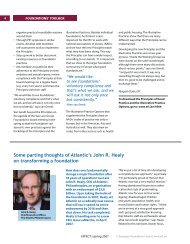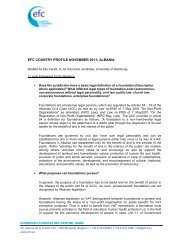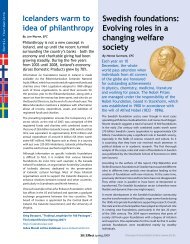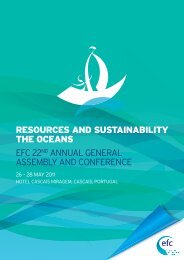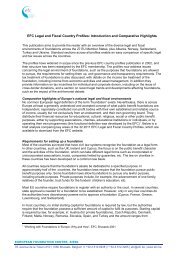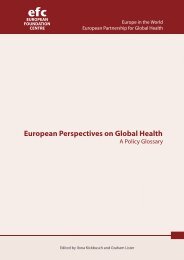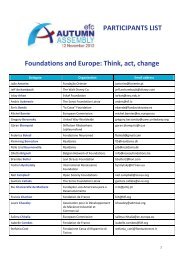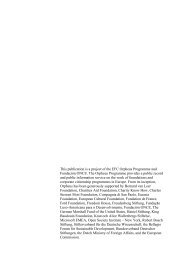2013 -EFC-DAFNE Position Paper - Foundations and VAT
2013 -EFC-DAFNE Position Paper - Foundations and VAT
2013 -EFC-DAFNE Position Paper - Foundations and VAT
Create successful ePaper yourself
Turn your PDF publications into a flip-book with our unique Google optimized e-Paper software.
exempt areas unless there was to be compensation of extra costs. A full taxation modelwould abolish social exemptions <strong>and</strong> would mean that any activity of a public body or publicbenefitorganisation would be taxable if carried out as an economic activity. In the first variantof this option, the <strong>VAT</strong> rates of previously exempt or non-taxable services are set to thest<strong>and</strong>ard <strong>VAT</strong> rate. In the second variant, the <strong>VAT</strong> rates of the previously exempt or nontaxableservices are set to the lowest reduced rate in the individual Member State or 5% if noreduced rate exists. A full taxation model in the full st<strong>and</strong>ard rate version would dramaticallyincrease the <strong>VAT</strong> burden on the sector at a time when it was being asked by governments todo more with less <strong>and</strong> when social welfare budgets were under huge strain in all MemberStates. The reduced rate variant would also be problematic, as it would not be revenueneutral for public-benefit foundations in the great majority of circumstances if, as suggested,the minimum acceptable rate was 5%. Knowing that for some public benefit foundations ataxation model could be of interest, we note that providing for an option to tax exempt social<strong>and</strong> other services in the public interest could be a possible <strong>and</strong> welcome scenario as it wouldleave it to the public-benefit organisation itself to decide whether to be taxed or not. Theproviders of the tax-exempt services would have a possibility to decide for the application ofthe output <strong>VAT</strong> on their supplies <strong>and</strong> thus open themselves the right to deduct the input <strong>VAT</strong>of purchases incurred for purposes of these outgoing supplies. This option was not mentionedin the latest CE report but was in the 2011 report, see pages 188-190,http://ec.europa.eu/taxation_customs/resources/documents/common/publications/studies/vat_public_sector.pdf6. The impact of policy option 3 of the CE report to abolish the regime enjoyed by the publicsector under Article 13 on public-benefit foundations would be limited <strong>and</strong> it would notaddress the growing burden of irrevocable input <strong>VAT</strong> cost mentioned under point 1above. The option 3 could potentially lead to increased contracting out of services by publicbodies to public-benefit organisations (for taxable supplies), as public bodies currently oftenprefer to perform those services in-house to save the <strong>VAT</strong> cost.BackgroundOn 10 January <strong>2013</strong>, the European Commission published a report on <strong>VAT</strong> in the public sector <strong>and</strong>exemptions in the public interest by Copenhagen Economics (The report, following up from a 2011study by Copenhagen Economics <strong>and</strong> KPMG, sets out the three policy options identified <strong>and</strong>assesses the impact of variants of these:http://ec.europa.eu/taxation_customs/resources/documents/common/publications/studies/vat_public_sector_exemptions_en.pdfOn 6 December 2011 the European Commission published the Communication on the future of ValueAdded Tax (<strong>VAT</strong>):http://ec.europa.eu/taxation_customs/resources/documents/taxation/vat/key_documents/communications/com_2011_851_en.pdfThe <strong>EFC</strong> <strong>and</strong> <strong>DAFNE</strong> are members of the European Charities Committee on <strong>VAT</strong> (ECC<strong>VAT</strong>)(http://www.eccvat.org/home), which has observer status to an expert group created in 2012 to assistthe European Commission during the current <strong>VAT</strong> review. For more information, please contacthsurmatz@efc.be<strong>EFC</strong> & <strong>DAFNE</strong>: <strong>Foundations</strong> <strong>and</strong> <strong>VAT</strong> April <strong>2013</strong> 2
About the <strong>EFC</strong>The European Foundation Centre (<strong>EFC</strong>), founded in 1989, is an association representing more than230 public-benefit foundations <strong>and</strong> corporate funders active in philanthropy in Europe <strong>and</strong> beyond.The <strong>EFC</strong> develops <strong>and</strong> pursues activities in line with its objectives: creating an enabling legal <strong>and</strong>fiscal environment for foundations; documenting the foundation l<strong>and</strong>scape; strengthening theinfrastructure of the foundation sector; <strong>and</strong> promoting collaboration, both among foundations <strong>and</strong>between foundations <strong>and</strong> other actors, to advance the public good in Europe <strong>and</strong> beyond.www.efc.beAbout <strong>DAFNE</strong><strong>DAFNE</strong> is a network with its own governance structure bringing together 23 donors <strong>and</strong> foundationsnetworks from across Europe. Each of these individually serves public benefit foundations <strong>and</strong> othergrantmakers at national level. With a collective membership of over 6,000 foundations, <strong>DAFNE</strong>underpins the individual activities of its members by strengthening collaboration between the nationalassociations <strong>and</strong> providing a platform for exchange of knowledge. The secretariat of <strong>DAFNE</strong> is hostedby the <strong>EFC</strong>.www.dafne-online.eu<strong>EFC</strong> & <strong>DAFNE</strong>: <strong>Foundations</strong> <strong>and</strong> <strong>VAT</strong> April <strong>2013</strong> 3



